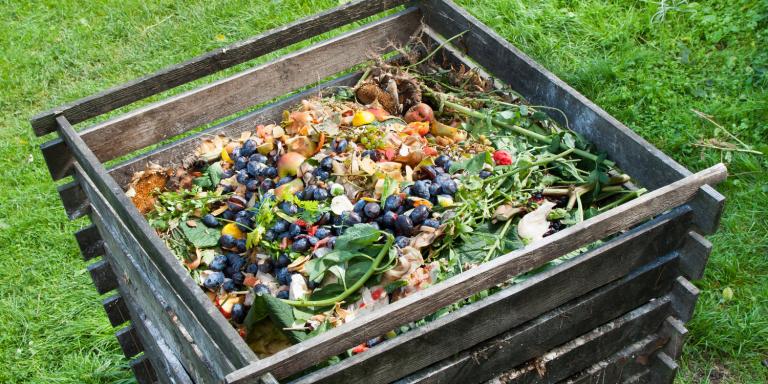The process of naturally breaking down organic matter into soil has been around since our planet first started sprouting plants. Humans have used composting since the days of hunting and gathering. One could imagine families and villages throwing all of their organic waste into a pile to rot and soon realizing that it made terrific soil to plant with. Thousands of years later, we still find a large amount of the population who take advantage of this natural process to help their gardens produce more, their house plants grow stronger, or simply to cut down on the waste they send to the landfill. The best part is that it is easier to do than you might think and doesn’t necessarily require a huge pile to work.
How Composting Works
Composting occurs when aerobic or anaerobic bacteria have the time grow on organic material and gradually break it down into soil. The key to having a successful composting system is keeping it aerated and having a good mix of materials. If air is unable to circulate within the pile or the mix is too heavy with one type of material, anaerobic bacteria will take over and cause your pile to compost slowly and smell like rotting garbage...Not the best thing if you have a small yard. To keep your compost pile full of aerobic bacteria, decomposing at a good rate, and not smelling like the local landfill, you need only remember a few things.
The Two Types of Compost Materials
First, it is important to know the two basic material groups and how to integrate them. A good compost pile is essentially made up of “browns” and “greens.”
Brown Materials for Your Compost Pile
Browns, as you might guess, are dead and dry materials. Fallen leaves, dead plants, dried hay, and woodchips are all common examples of browns that you might include into your pile. These materials contain sugar molecules that provide food energy for the bacteria. Because they are often dry and rigid, they also allow air to better circulate within the pile. It is important to properly moisten browns when mixing them, as bacteria grow better in damp conditions.
Even Your Compost Pile Needs Greens
Greens are grass clippings, vegetable scraps, fruit, egg shells, weeds from the garden, coffee grounds, tea bags etc. They have inherent moisture in them as well as higher levels of nitrogen than browns, which acts as a protein source for the billions of microbes decomposing your pile. It is important to remember that because greens have more moisture than browns, you need to mix them in well or make thin layers of them. If you, for example, have a large concentrated pile of grass clippings, they will mat down and block the air circulation. Therefore, either mix the grass clippings into the pile or, if you have a large yard, create a separate pile for the cut grass.
The Remaining Elements Required for a Healthy Compost Pile
Now that you have the food for the pile, you need to make sure it gets air and water…but not too much water. Ideally you want your pile to be as moist as a wrung out sponge. To ensure air circulation you should mix the pile well and occasionally break it up or turn it over with a spade or pitchfork. While hotter piles will decompose faster, you do not need yours to be hot to work. As long as it has the materials, water, and air, a compost pile will work fine in 50 degrees Fahrenheit or above. If you live in a hot and dry climate, you may need to water the pile so that it doesn’t dry out. If you live in a rainy climate you may want to cover your pile with a tarp during rainstorms. And if you live in a colder climate, you can expect the pile to go dormant during the winter if it freezes. But don’t worry, as soon as it gets warm outside the process will start back up again.
As you can see, the process of composting is fairly simple and will provide you will soil that can be more effective than most store bought chemical fertilizers. You will know that your soil is ready when it has a dark brown look to it and you can no longer recognize the material you had originally put on the pile. However, depending on your application, you will want to use the soil at different phases of the decomposition process. If you are using it for your garden you can use the pile when the materials are mostly all unrecognizable as they will continue to compost in your garden. But, if you are using it for houseplants you will want to wait until it is fully decomposed or the bacterial microbes may damage the plants roots.
Proper Composting Technique Review
- Browns and Greens are the two main groups of materials you can compost. Browns are dead and dry materials like autumn leaves, hay, dead plants and woodchips. Greens are fresh and moist materials like grass clippings, garden weeds, and kitchen food scraps.
- To have a good compost pile you need to mix the materials well so that air will circulate. The pile should be as moist as a wrung out sponge.
- Avoid placing large amounts of grass clippings in concentrated piles. They will prevent air circulation.
- Break up the pile and turn it over occasionally. When older compost begins resembling soil, separate it from the new compost to finish its process.
- Garden soil can be used sooner than house plant soil.
- Depending on your climate you may want to water the pile or place a tarp on it when it rains.
- Composting adds crucial nutrients to your existing soil as well as improves the way water interacts with your garden or house plants. The microbes inoculate the existing soil and aid in transferring nutrients to your plants.
- You can make a compost pile in the corner of your yard, build a bin to contain it or buy one from sites like www.cleanairgardening.com
Further information can be found at:

